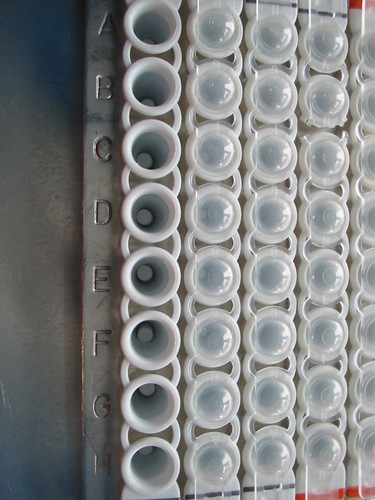
It is an exciting time to be following progress in the field of microbial ecology. While the awareness of the abundance of microscopic organisms is not new, the development of new methods to observe the microscopic world continue to deepen our understanding. Some of these methods have been described briefly on this blog. See the entry on
454 sequencing for example.
One of the most important techniques for modern microbial ecology and biology as a whole is the polymerase chain reaction or PCR. I suspect most of my modest readership is familiar with the technique, if any of you are not, it is something that you ought to take the time to learn about.
A google search of the term PCR reveals a large number of pages devoted to explaining the technique. Many people have also developed diagrams and animations to aid in the understanding. The problem is, most of the good animations do not stand on their own. To make use of them, some background knowledge is needed.
The best animation I have seen on the web is
this one. Go ahead and look at both the amplification animation and the interactive graph showing the number of copies of the target molecule present after each cycle.
Here are some things to keep in mind:
- DNA is a double stranded molecule and the two strands are held together by hydrogen bonds. Each individual bond is weak, the strength of the bonding between the two strands arises from the sheer number of individual bonds present. Key point for PCR: The bonding that holds the double strand together is easily disrupted by heat. Thus the 95 deg C steps
- DNA is made up of 4 nucleotides: adenine, thymine, cytosine and guanine attached to each other along a sugar-phosphate backbone. The hydrogen bonding between the two strands of the double stranded molecule are between these nucleotides. The pairing of the nucleotides is specific. Adenine always binds with thymine and guanine with cytosine. Key point for PCR: knowing the sequence of one of the strands of the double stranded DNA makes it possible to deduce the sequence of the opposite strand.
- DNA polymerase is the enzyme required for PCR. The enzyme is capable of synthesizing double stranded DNA from single stranded DNA using the single strand as a template. The activity of this enzyme is specific in several ways. Most importantly for PCR:
- The nucleotide bases strung along the sugar-phosphate backbone of each DNA strand has directionality.a and each of the two strands in the double stranded molecule are oriented in the opposite direction. DNA polymerase can elongate in only one direction. Key point for PCR: the DNA polymerase must elongate each of the two strands from opposite ends.b
- DNA polymerase can not elongate single stranded DNA. A short fragment of double stranded DNA is needed. Key point for PCR: Small lengths of double stranded DNA need to be created flanking the region targeted for amplification (these are the primers).
- The exponential nature of PCR amplification depends on multiple cycles of amplification involving both strands of the double stranded molecule. Key point for PCR: Two primers are needed.
The ingredients needed for a PCR reaction are:
- DNA polymerase - the enzyme.
- 2 primers - Small fragments of single stranded DNA. These are used to produce short regions of double stranded DNA flanking the sequence targeted for amplification.
- Free nucleotides - These must be in the form of nucleotide triphosphates. In this form, they provide the source of the bases needed to build new strands of DNA and the energy required to drive the reaction.
- Template - some DNA containing the region that is to be targeted.
When I teach people the basics of PCR, a question I use to assess comprehension is: How many cycles of amplification are needed to produce the first copies of the target fragment that are the correct length and why are are none produced prior to this cycle? If you can answer that question, you understand much of the basics of PCR.
There is much more to say about PCR but this post is already long enough so go enjoy the animation.
aFor a better understanding of the structure of the DNA molecule itself see
DNA is a polynucleotide by Larry Moran at
Sandwalk.
bSee
here and
here for an interesting exception to this rule on directionality.
Image from
Flickr


